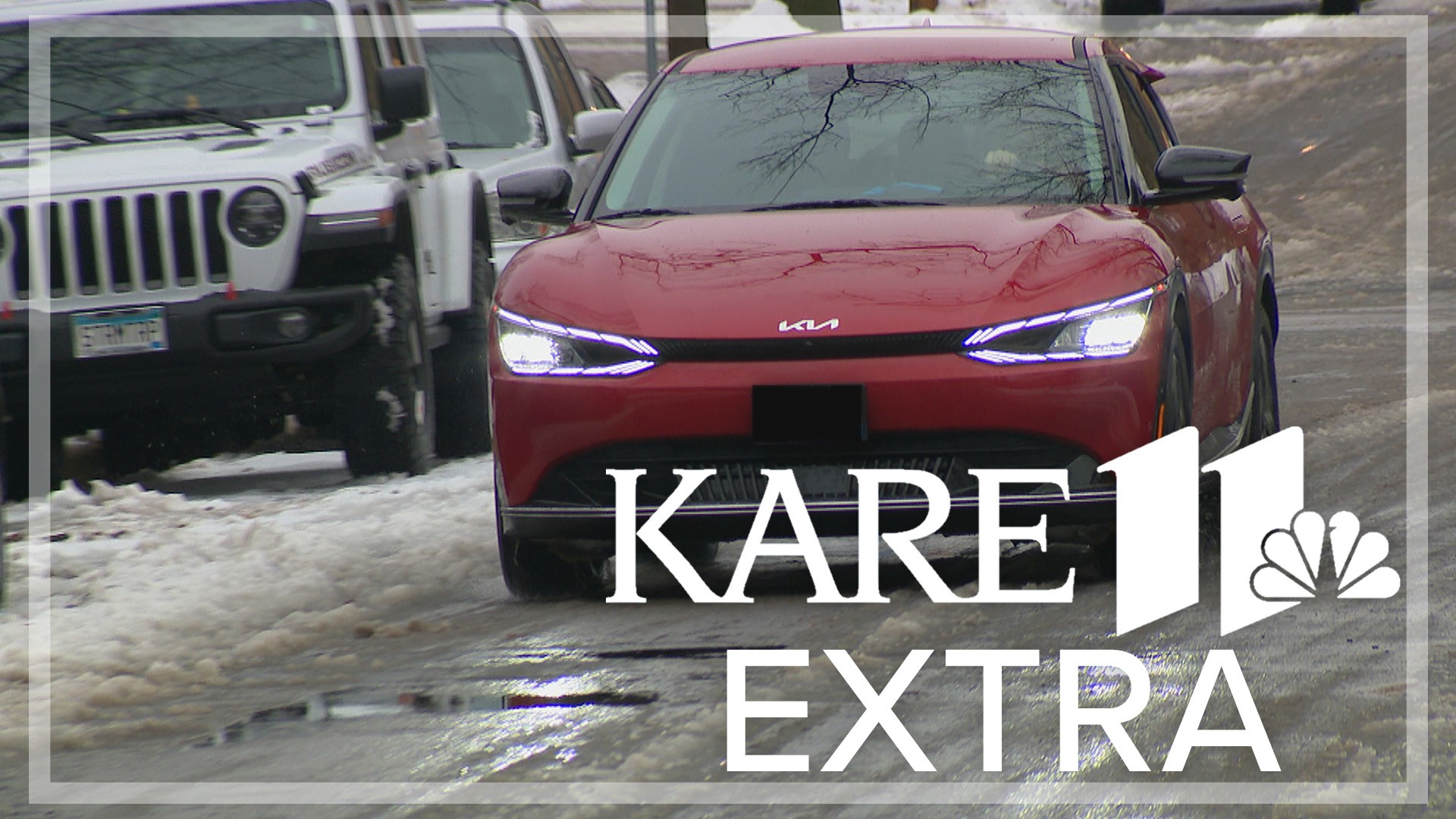MINNEAPOLIS — Electric vehicles are becoming more popular these days, but one of the biggest concerns from potential buyers is the range, especially when it is cold outside and batteries lose some of their power.
Is it really a big deal? Or is this all overblown?
"This is my Kia EV6,” said Amy Gustafson, a Minneapolis resident. "This is new in the U.S. this year."
New, so it's never experienced a Minnesota winter before.
"I’d say the cold puts me down at about the 250-something range,” Gustafson explained.
During the spring and summer, Gustafson says her Kia can typically drive around 300 miles on a full charge.
So, she loses around 50 miles of range during the winter.
"It's because you're using a lot of electricity to warm up the car. Driving in the snow is also a factor,” Gustafson says.
She says the range can change drastically depending on how much the heater is running. Gustafson runs her heater at a higher temperature, the range reading adjusted almost immediately.
"If you run that real high, that's going to use as much, or even more energy than the drive itself,” Gustafson said.
She has learned some tricks over the years to help her save energy during the winter.
“Sometimes I will just use the seat warmers and the steering wheel warmer, and I’ll have these thick blankets for my kids and that’s enough to keep everyone comfortable without running the heater very high,” Gustafson said.
On average, Gustafson says her Kia EV6 loses about 25% of its range during the winter, which she says is a lot better than the Tesla she bought five years ago.
"With the Tesla, I would say that I was probably seeing more like 40% less,” Gustafson said. "My 2017 Tesla didn't have some of the same technology that helps to boost my range in this vehicle. These vehicles have really changed a lot in recent years and that has helped with the range during the winter."
That's what Gustafson has seen with her experience, but what about other drivers?
Alex Knizek is an engineer with Consumer Reports. He and his team recently tested four electric vehicles in three different temperatures.
"We did a cold day, kind of the middle of the winter. It was maybe 15 degrees or so. And we also did testing in the spring time, 65 degrees. And also in the summer when it was between 80 and 85 degrees,” Knizek explained.
They saw the highest range during the summer and the lowest during the winter.
"In the winter time compared to the EPA range for these vehicles, we saw an average of about 25% reduction in the range,” Knizek says.
During their testing, Knizek says the vehicles were averaging around 170 to 190 miles on a full charge when the outside temperature was around 15 degrees.
What about even colder temps, say zero degrees, or negative 15 degrees?
“We didn’t test the EVs at below zero temperatures, so it’s hard to say whether there’s a linear relationship, and you’re going to see the same steady drop at even lower temperatures than 15 degrees," Knizek explained. "Though, you'll probably reduce it even further as temperatures get colder."
EV owners say you can also lose range by just parking outside in the cold when the car isn't even running. A test showed Tesla lost 16 miles of range when it was parked in 22-degree temperatures for eight hours.
"These lithium ion batteries that EVs are using these days are very sensitive to temperatures,” Knizek explains.
One trick to get more range out of an EV is to warm up the vehicle while it's plugged in, so you're using the power from your charger and not from your battery.
Gustafson says EVs also get better range while driving on city streets versus the highway.
"Stopping and starting a lot really gives you more range,” Gustafson explained.
That's because EVs use "regenerative braking."
"Every time I take my foot off the gas, the vehicle is then recouping that power from the friction in the motors,” Gustafson said.
So, we've shown that EVs do lose range in the cold, but is it a reason to be concerned?
"You talk about range anxiety and it's interesting, some people get very worried about it,” Gustafson said.
Range anxiety is definitely a concern for some people as they worry whether an EV will run out of power during their drive. However, Gustafson says it’s not something that she worries about with her EV.
"I've never gotten to the point where I was worried about getting stranded,” Gustafson explained. “It hasn’t happened to me yet and I drive up to cabins and the North Shore all the time, and I find ways to keep it charged.”
Gustafson’s charger will give her Kia EV6 around 40 miles of range for every hour that it’s charging.
She says she can start every morning with a full battery.
"For most drivers, if you're not driving 300 miles a day, it doesn't really matter that much, because you can usually start with a fresh battery every day,” Gustafson said. "I think most people have to ask themselves realistically, how do they drive, where do they drive on a daily basis.”
To take a deeper look at the study from Consumer Report, click here. Drive Electric Vermont and AAA also published articles about the impact cold temperatures have on EVs.
Watch more local news:
Watch the latest local news from the Twin Cities in our YouTube playlist:

